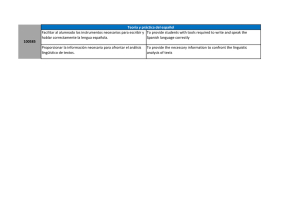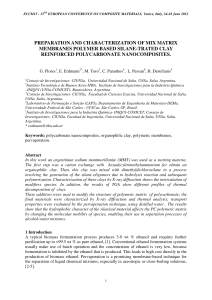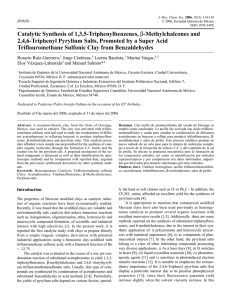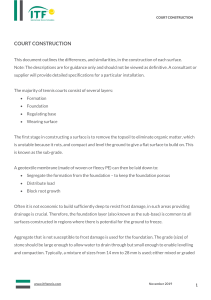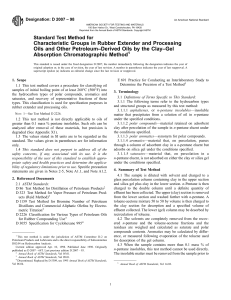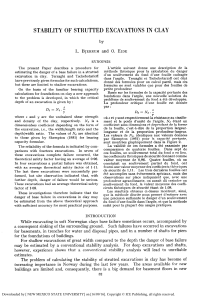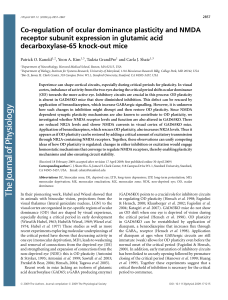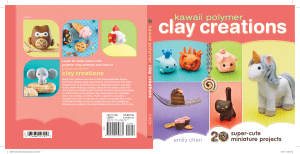Raw materials for the ceramics industry from norte de santander. I
Anuncio
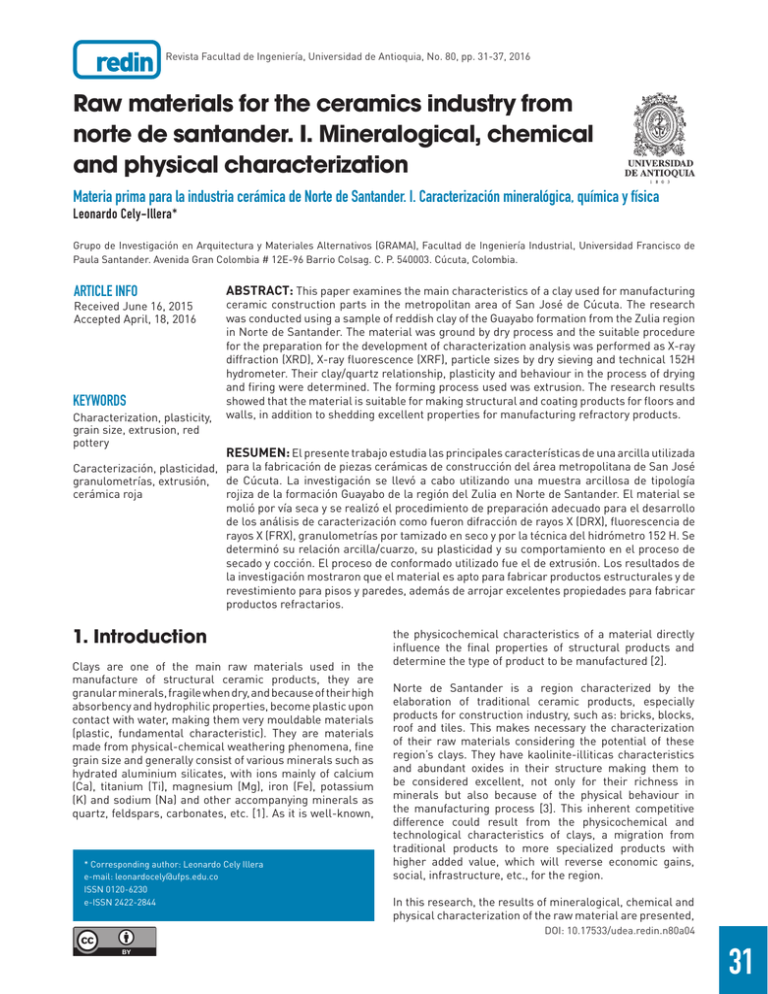
L. Cely-Illera; Revista Facultad de Ingeniería, No. 80, pp. 31-37, 2016 Revista Facultad de Ingeniería, Universidad de Antioquia, No. 80, pp. 31-37, 2016 Raw materials for the ceramics industry from norte de santander. I. Mineralogical, chemical and physical characterization Materia prima para la industria cerámica de Norte de Santander. I. Caracterización mineralógica, química y física Leonardo Cely-Illera* Grupo de Investigación en Arquitectura y Materiales Alternativos (GRAMA), Facultad de Ingeniería Industrial, Universidad Francisco de Paula Santander. Avenida Gran Colombia # 12E-96 Barrio Colsag. C. P. 540003. Cúcuta, Colombia. ARTICLE INFO Received June 16, 2015 Accepted April, 18, 2016 KEYWORDS Characterization, plasticity, grain size, extrusion, red pottery ABSTRACT: This paper examines the main characteristics of a clay used for manufacturing ceramic construction parts in the metropolitan area of San José de Cúcuta. The research was conducted using a sample of reddish clay of the Guayabo formation from the Zulia region in Norte de Santander. The material was ground by dry process and the suitable procedure for the preparation for the development of characterization analysis was performed as X-ray diffraction (XRD), X-ray fluorescence (XRF), particle sizes by dry sieving and technical 152H hydrometer. Their clay/quartz relationship, plasticity and behaviour in the process of drying and firing were determined. The forming process used was extrusion. The research results showed that the material is suitable for making structural and coating products for floors and walls, in addition to shedding excellent properties for manufacturing refractory products. RESUMEN: El presente trabajo estudia las principales características de una arcilla utilizada Caracterización, plasticidad, para la fabricación de piezas cerámicas de construcción del área metropolitana de San José granulometrías, extrusión, de Cúcuta. La investigación se llevó a cabo utilizando una muestra arcillosa de tipología cerámica roja rojiza de la formación Guayabo de la región del Zulia en Norte de Santander. El material se molió por vía seca y se realizó el procedimiento de preparación adecuado para el desarrollo de los análisis de caracterización como fueron difracción de rayos X (DRX), fluorescencia de rayos X (FRX), granulometrías por tamizado en seco y por la técnica del hidrómetro 152 H. Se determinó su relación arcilla/cuarzo, su plasticidad y su comportamiento en el proceso de secado y cocción. El proceso de conformado utilizado fue el de extrusión. Los resultados de la investigación mostraron que el material es apto para fabricar productos estructurales y de revestimiento para pisos y paredes, además de arrojar excelentes propiedades para fabricar productos refractarios. 1. Introduction Clays are one of the main raw materials used in the manufacture of structural ceramic products, they are granular minerals, fragile when dry, and because of their high absorbency and hydrophilic properties, become plastic upon contact with water, making them very mouldable materials (plastic, fundamental characteristic). They are materials made from physical-chemical weathering phenomena, fine grain size and generally consist of various minerals such as hydrated aluminium silicates, with ions mainly of calcium (Ca), titanium (Ti), magnesium (Mg), iron (Fe), potassium (K) and sodium (Na) and other accompanying minerals as quartz, feldspars, carbonates, etc. [1]. As it is well-known, * Corresponding author: Leonardo Cely Illera e-mail: [email protected] ISSN 0120-6230 e-ISSN 2422-2844 the physicochemical characteristics of a material directly influence the final properties of structural products and determine the type of product to be manufactured [2]. Norte de Santander is a region characterized by the elaboration of traditional ceramic products, especially products for construction industry, such as: bricks, blocks, roof and tiles. This makes necessary the characterization of their raw materials considering the potential of these region’s clays. They have kaolinite-illiticas characteristics and abundant oxides in their structure making them to be considered excellent, not only for their richness in minerals but also because of the physical behaviour in the manufacturing process [3]. This inherent competitive difference could result from the physicochemical and technological characteristics of clays, a migration from traditional products to more specialized products with higher added value, which will reverse economic gains, social, infrastructure, etc., for the region. In this research, the results of mineralogical, chemical and physical characterization of the raw material are presented, DOI: 10.17533/udea.redin.n80a04 31 L. Cely-Illera; Revista Facultad de Ingeniería, No. 80, pp. 31-37, 2016 in addition to setting the best operating conditions, ceramics suitability of the material and its potential application in the manufacture of different ceramic pieces to the ones traditionally obtained 2.Materials and methods 2.3. Methods Raw material for different characterization tests outlined above by international standards 4113-1 NTC, NTC 4113-2, ASTM D422-63, ASTM C323-56, ASTM C324-01 and ASTM C325-81 were prepared. 2.1. Raw material Sample preparation The investigated clay comes from the region of el Zulia, municipality of Norte de Santander; that area has traditionally been an important construction materials production place; it belongs to the Guayabo formation of reddish and plastic texture. The collected in situ sample was tested according to the 4113-1 NTC and 4113-2 NTC procedures, the moisture content was determined and then the drying process was performed at 110±5 °C. After drying the sample, pregrinding was performed to a size of 10 mm [4]. Then it was crushed in a hammer mill to a size not exceeding 2 mm, in order to obtain a homogeneous and uniform particle size. It was then sieved to a ASTM 10 mesh being prepared for analysis of physical characterization. An outline of the analyses is shown in Figure 2. 2.2. Equipment used The equipment used for the development of this research are: a brand powder diffractometer Bruker D8 Advance model, a X-ray fluorescence Axios Panalytica, a laboratory extruder with empty model New Wave Metal Souza Ltda. with rectangular mold laboratory hammer mill brand Servitech model CT-058, two stoves, the first brand Gabrielli Stainless steel with natural ventilation from a range of 0 °C to 300 °C and the second Dies with electric resistance heating, vibrating screen brand Gabrielli, ASTM mesh sieve set 10 (2000 μm), 30 (600 μm), 60 (250 μm), 80 (180 μm), 100 (150 μm) and 120 (125 μm), plasticity equipment of Pfefferkorn, a brand muffle furnace Gabrielli, digital scale mark 1500 g capacity OHAUS adventurer 0.01 g sensitivity, thermobalance Ohaus MB45 and sensitivity 0.0001 g, hydrometer 152 H and Mitutoyo digital caliper brand and sensitivity 0.01 mm. Figure 1, shows some equipment used. Mineralogical and chemical testing • Determining the chemical composition: The chemical composition was determined by X-ray fluorescence (XRF) according to ASTM standard C323-56, obtaining the percentage of oxides present as shown in Table 1. Table 1 Chemical analysis of raw • Determination of the mineralogical composition: The mineralogical composition of the samples was performed by X-ray diffraction (XRD) under working conditions of 0º to 40º degrees 2θ. Diagrams have been obtained corresponding to the oriented samples, oriented with glycerine and calcined at 550 °C. The diffractogram is shown in Figure 3. Technological analysis Source: Centro de Investigación de Materiales Cerámicos –CIMAC- (UFPS) Figure 1 Equipment needed for the development of research 32 • Sieve analysis by hydrometer 152 H: It was performed on 50 g of sample. L. Cely-Illera; Revista Facultad de Ingeniería, No. 80, pp. 31-37, 2016 Figure 2 Analysis performed in research Source: brand powder diffractometer Bruker D8 Advance model. • Plasticity: the dry milled sample was used to determine the plasticity index using the Pfefferkorn method [5]. The result is shown in Table 2. Table 2 Results of plasticity index • Figure 3 X-ray diffractograms of MI Sieve analysis by dry sieving: the particle size was determined using a representative sample of 100 g, the assay was performed using dry-sieve opening mesh ASTM 10 (2000 μm), 30 (600 μm), 60 (250 μm), 80 (180 μm), 100 (150 μm) and 120 (125 μm) and collector, the results can be seen in Figure 4. 33 L. Cely-Illera; Revista Facultad de Ingeniería, No. 80, pp. 31-37, 2016 Figure 4 Particle size analysis screening for dry Figure 5 Specimens shaped extrusion Bigot curve 3. Results and discussion To perform the Bigot curve analysis, test tubes were formed, initially the material was wetted and left to stand for 12 h to homogenize the clay mass. Subsequently, the forming process, which is performed by extrusion, obtaining rectangular specimens of dimensions 11cm x 1cm x 4cm (Figure 5) was started. The drying process was conducted at three temperatures 30±5 ºC; 60±5 °C and 80±5 °C. 3.1. Study Physical - Chemical Gresification diagram The cooking stage was analysed to determine the firing temperature and the temperature range of the material, it was taken into account temperatures normally used in the region for structural materials and it was performed in the temperature range of 950 ºC to 1100 °C at 50 °C gradients. The heating rate of the muffle furnace used for firing was 1.67 °C/min with 30 min at peak temperature table. Cooling is produced by natural convection within the furnace after off. 34 As detailed in Figure 3, from the oriented sample it is observed that the major peaks are associated with kaolinite (K) and illite (I), this matches most clays found in the eastern region of North Santander; Quartz also has contributions (Q) with a principal line at 3.34 Å. The diffraction characteristics of the kaolinitic minerals are present in the diffractogram 7.14; 4.24; 3.57; 2.38 Å; There are also diffractions illite: 4.97; 4.47; 2.45 Å, and it can be precised that the existing carbonate is calcite, which occurs in diffraction 2.28 Å [6]. Likewise, in this diagram 4, Å line between position 20 to 21θ appears, when analysing glycol is still listed as line 4 Å but it has taken a bit to a position 21θ, it has run completely and has decreased after calcinated at 550 °C for two hours which suggests, without any doubt, the presence of kaolinitic. L. Cely-Illera; Revista Facultad de Ingeniería, No. 80, pp. 31-37, 2016 It may indicate a significant presence of free silica because the intensity peak of quartz and the high molar ratio SiO2/ Al2O3 [2, 7, 8]. According to the results of chemical analysis, which is shown in Table 1, K2O content of samples reaches a value of 1.63%, a fact that suggests the existence of micaceous minerals in relatively high proportions, although the existence of other layered minerals cannot be ruled out. The Fe2O3 content seems to indicate the presence of free iron oxides and the low content of alkali oxides and alkaline gives the possibility to the clay to generate the glass phase at relatively high temperatures, which is a property of semirefractory, corroborating the data obtained in XRD analysis [2, 9-11]. 3.2. Technological study In the results in Figure 6, it is observed that in the distribution of fractions it is predominant the clay material with a percentage of 68.93%, this is the reason for its high plasticity as shown in Table 2, followed by fraction silty finemedium 27.73%, it can be concluded that this fraction also helps the development of plasticity; finally, the sand fraction is 3.34% and it is associated with spherical particles with a diameter greater than 2 mm indicating that generally is silty clay samples. The clay fraction is associated with very fine clay minerals that are primarily responsible for the plasticity of the same; so its grain size is suitable for all kinds of ceramic applications. As shown, this plasticity index 28.3%; This index corresponds to the amount of water needed to reach the clay a plastic consistency, enabling extrusion molding. For practical purposes, it should be above 10%, so they are suitable for the production of structural products, common manufacturing in the region. Besides, above this percentage it will not be at risk of problems during forming material, as may be inappropriate size or cracks in raw parts. In cases where the clay has to be mixed with raw materials with coarser particle size materials such as sands or degreasing chamotte or cooked, to decrease the plasticity and improve the compactness thereof, these materials should not exceed 30% by weight, in order to avoid without moldability material becomes as shown in Figure 4 [12, 13]. Figure 6 Sample fractions textural Figure 7 Bigot curve 35 L. Cely-Illera; Revista Facultad de Ingeniería, No. 80, pp. 31-37, 2016 3.3. Bigot curve It was performed to observe the behaviour of the material in the drying step, mainly by determining the rate of shrinkage of the sample at different selected temperatures and relating the drying losses with shrinkage percentage dry the shaped specimens (Figure 7). Critical parameters such as relative humidity, air temperature, drying rate but mainly contraction speed, may cause, if not working to optimum values, the formation of internal defects, which are undetectable during the drying cycle but quite problematic in the cooking process [14]. The results obtained for contraction rates in different drying cycles were investigated 0.027%/ min to 30 °C, 0.037%/ min to 60 °C and 0.036%/ min to 80 °C. The studies performed show a similar behaviour, but concluded that the best performance is obtained at room temperature 30±5 °C, because the speed of contraction is this lower temperature which will have a high risk of breakage during the process [15]. 3.4. Gresification diagram The Gresification diagram allows the determination of the firing temperature and the temperature range, looking forward to annulling the open porosity and the shrinkage remains constant indicating that it generates products of high mechanical strength by the low porosity of the material [16, 17]. In Figure 8, the curve gresification diagram details that the clay has no significant changes to 1050 °C, however above this temperature, an increase occurs in linear shrinkage and a decrease in water absorption, so the sample above 1050 °C and below 1100 °C generates stability in their crystalline components, a minor vitreous phase leads to a decrease in the deformation of the work piece and reduce the chances of defects in them. This performance at high temperatures is associated with the mechanism of sintering, which densifies the sample and reduces the porosity, this reduction brings benefits such as an excellent vitrification and increased mechanical strength of the product, fundamental characteristics for the production of structural materials. This can be explained by the influence of the kaolinite structure and low content of alkali oxides and alkaline causing a refractory behaviour characteristics observed in Figure 3 and Table 1. Figure 8 Gresification diagram sample 4. Conclusions After the overall analysis of all the results, it can be summarized that the clay is a mixture of laminar minerals such as illite and kaolinite, accompanied by quartz. The high content of iron oxide and potassium oxide confirm the presence of illitic minerals. Nowadays, the clay is used to make building materials but due to the high percentage of alumina is an excellent raw material for manufacturing refractory products with higher value added, although it is clear that the iron oxide presents difficulties when used in the preparation of articles white hue (porcelain and earthenware). 36 The clay granulometry has fine size, allowing the addition in the complementary shaping raw materials which will provide improvements in certain aspects such as dimensional stability, better compaction and a better finish. Drying curves are very similar for all samples at any temperature condition but it should be noted that a slow drying (natural) should be performed in order to better control the speed of contraction and avoid defects in the products that would be pronounced in cooking. Clay has low water absorption and stability of linear shrinkage below 1100 °C, indicating that it is excellent in L. Cely-Illera; Revista Facultad de Ingeniería, No. 80, pp. 31-37, 2016 regional processes but must have a special control above this temperature to avoid internal stresses that generate cracks and fractures in the finished product. 5. Acknowledgements The author express their gratitude to the Research Center of Ceramic Materials -CIMAC- of Francisco de Paula Santander University Cúcuta-Colombia for their support in the performance of the trials, also to the company CEMEX Colombia by the test X-ray fluorescence. 6. References 1. S. Mukherjee, The science of clays. Applications in industry, engineering and environment, 1st ed. New Delhi, India: Springer, 2013. 2. J. Santos, P. Malagón and E. Córdoba, “Caracterización de arcillas y preparación de pastas cerámicas para la fabricación de tejas y ladrillos en la región de Barichara, Santander”, Dyna, vol. 78, no. 167, pp. 5361, 2011. 3. J. Gelves, R. Monroy, J. Sánchez and R. Ramírez, “Estudio comparativo de las técnicas de extrusión y prensado como procesos de conformado de productos cerámicos de construcción en el área metropolitana de Cúcuta”, Bol. Soc. Esp. Ceram. Vidr., vol. 52, no. 1, pp. 48-54, 2013. 4. J. Amorós, E. Sánchez, J. García, V. Sanz and M. Monzó, Manual para el control de la calidad de materias primas arcillosas, 1st ed. Castellón, Spain: Instituto de Tecnología Cerámica, 1998. 5. A. Querol, “Aplicación del método de Pfefferkorn al control de la plasticidad en pastas de extrusión”, Bol. Soc. Esp. Ceram. Vidr., vol. 22, no. 2, pp. 285-289, 1983. 6. F. Sandoval and J. González, “La arcilla ilítica en la obtención de porcelanas de alta resistencia mecánica. I Materias primas”, Bol. Soc. Esp. Ceram. Vidr., vol. 20, pp. 105-112, 1981. 7. C. Coelho, N. Roqueiro and D. Hotza, “Rational mineralogical analysis of ceramics”, Materials Letters, vol. 52, no. 6, pp. 394-398, 2002. 8. I. Bernal, H. Cabezas, C. Espitia, J. Mojica and J. Quintero, “Análisis próximo de arcillas para cerámica”, Rev. Acad. Colomb. Cienc, vol. 27, no. 105, pp. 569-578, 2003. 9. C. Vieira, R. Sánchez and S. Monteiro, “Characteristics of clays and properties of building ceramics in the state of Rio de Janeiro, Brazil”, Construction and Building Materials, vol. 22, no. 5, pp. 781-787, 2008. 10. T. Antequera, E. Tolabín, M. Camacho, A. Gareca and A. Ugarte, “Estudio de propiedades físicas y químicas de materias primas destinadas a la elaboración de productos estructurales”, in Congreso Regional de Ciencia y Tecnología NOA, Catamarca, Argentina, 2002, pp. 1-10. 11. A. Escardino, J. Enrique and E. Ramos, “Arcillas cerámicas de la región valenciana. Estudio de algunas arcillas empleadas en la abricación de azulejos en las provincias de Castellón y Valencia”, Bol. Soc. Esp. Ceram. Vidr., vol. 17, no. 2, pp. 83-90, 1977. 12. A. Fernández, C. Sanchez, J. Parras and A. Acosta, “Caracterización tecnológica de las materias primas cerámicas de la Sagra (Toledo)”, Geogaceta, vol. 20, no. 3, pp. 713-716, 1996. 13. J. Espinosa, D. Alvarez, F. Morales and M. del Río, “Arcillas sericíticas. Nuevas materias primas cerámicas”, Bol. Soc. Esp. Ceram. Vidr., vol. 17, no. 2, pp. 73-78, 1978. 14. V. Lee and T. Yeh, “Sintering effects on the development of mechanical properties of fired clay ceramics”, Materials Science and Engineering: A, vol. 485, no. 1-2, pp. 5-13, 2008. 15. F. Genel, D. Minichelli and F. Battistella, “Estudio para la optimización del proceso de secado de las pastas”, in VIII World Congress on Ceramic Tile Quality (Qualicer), Castellón, Spain, 2004, pp. 19-24. 16. A. Escardino, J. Amoros and J. Enrique, “Estudio de pastas de gres para pavimentos”, Bol. Soc. Esp. Ceram. Vidr., vol. 20, no. 1, pp. 17-24, 1981. 17. L. Cely and R. Bolivar, “Materia prima para la industria cerámica de Norte de Santander. II. Evaluación del comportamiento térmico y su incidencia en las propiedades tecnológicas”, Respuestas, vol. 20, no. 1, pp. 84-94, 2015. 37


